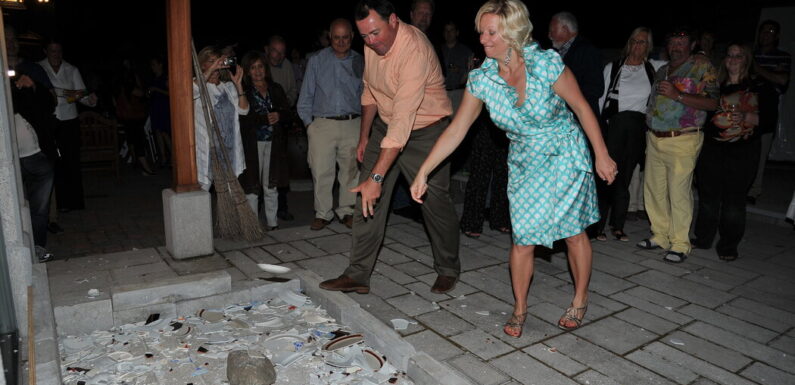
Weddings are steeped in tradition, but where did those traditions come from? And how do those customs differ in other cultures? In our new column, “Traditions,” we aim to explore the origins of various wedding customs from the United States and around the world.
On the night before a wedding, a purposeful cacophony of shattering plates at a party isn’t the norm — unless you are participating in the Polterabend, a German tradition that means “eve of making a racket.”
On July 9, 2011, Ingrid Busson-Hall embraced the Polterabend tradition the evening before her wedding. She married Scott Hall, 56, a co-founder of Althub, an investment consulting service, at her parents’ home in St.-Sauveur, Quebec.
“My mother is German,” said Ms. Busson-Hall, 49, a regulatory and enforcement lawyer. “My parents had a Polterabend at their wedding. This honored my mom’s side of the family.”
For the couple’s Polteraband, a friend built a wooden box the size of a dining table. After the couple explained the tradition to 100 wedding guests, they threw the first plate together into the box. Their guests followed suit — everyone had been asked to bring a porcelain dish or cup from home.
“Some guests shouted good wishes when they smashed their plates, others danced,” Ms. Busson-Hall said. “We swept up the pieces that spilled out of the box together, which was my favorite part. It’s a reminder that while building a life together, things break, but none strong enough to break the bond of marriage.”
Shards of Tradition
The origins of such rituals are often impossible to trace, said Joel F. Harrington, a professor of history who specializes in early modern Germany at Vanderbilt University in Nashville.
“These pre-Christian, Germanic customs have become about two parts: scaring off evil spirits because of the loud noise made by the broken plates, and shards bringing luck, something everyone wants,” he said.
In ancient times, shards were made from breaking clay pots. The belief was that “‘shards bring luck,’ which became ‘broken shards bring luck,’” Dr. Harrington said, adding that traditions generally originate from sayings. “The first record of Polterabend is during the 16th century. When it actually started, we don’t know.”
The act of breaking plates is believed to represent a couple’s first moment of unity and teamwork. The evolution of this ritual, Dr. Harrington said, is likely to be recent: It “was probably introduced during the 18th and 19th century, as romantic love in culture and literature came into focus,” he said. “People add new interpretations to the customs, that’s why they get reinvented. As time goes on, it accumulates different meanings and iterations.”
For Meena Lee-DePasquale, the owner and designer at 5th Avenue Weddings & Events, a wedding planning company in Manhattan, the continuation of traditions and culture is crucial. “I’m known for mixed-culture weddings,” Ms. Lee-DePasquale said. “Blending those cultures together is best done by understanding customs, traditions and rituals.”
For the past 13 years, Ms. Lee-DePasquale has worked with couples to incorporate their cultures into modern celebrations. For a wedding that combined Hawaiian Japanese and American Latin cultures, “we had custom sake cups made for each guest to do the traditional Hawaiian banzai toast and served musubi during cocktail hour, as well as had cherry blossom centerpieces,” she said. She has also planned Indian and Quaker, as well as Jewish and Chinese celebrations.
“People smashed porcelain, stoneware and pottery back in medieval times as opposed to glass, which was considered good luck and owned by the wealthy,” she said. “The noise from the broken plates was to ward off evil spirits. The more shards, the more luck the couple would experience.”
Centuries later, a second step in this ritual emerged.
“The couple sweep up the broken shards together to chase away the evil spirits and to represent their first shared task,” Ms. Lee-DePasquale said. “It symbolizes working as a team in life and in their marriage.”
A Modern Spin on Fragments
As destructive as it may appear, the symbolic custom of shattering items during wedding events is common in many cultures. For instance, Greek weddings also entail smashing plates, while couples at Jewish wedding ceremonies deliberately step on glass to break it.
“In Guatemala, a groom’s mother will often wear a white ceramic bell, usually filled with rice, which she breaks open once the couple is married,” said Claire Stewart, an associate professor of hospitality management at New York City College of Technology at the City University of New York. “She breaks the bell for good luck. The rice is for fertility.”
All of these acts are visual and auditory demonstrations in most cultures, “a disruption to indicate this is a special day and is to be remembered,” added Ms. Stewart, who is also the author of “As Long as We Both Shall Eat: A History of Wedding Food and Feasts.”
But the Polterabend is unique, “as the ritual originally took place the night before,” Ms. Lee-DePasquale said, “rather than at the wedding, say, like Greek or Jewish customs generally state.” Recently, more couples have asked her to incorporate these traditions into weddings.
And over the years, despite the adaptations and variations to the Polterabend, the sentiment remains the same.
Today, extra-thin and inexpensive specialty plates — specifically made for breaking — are starting to replace porcelain and pottery. And rather than throwing the plates away from themselves, “people are throwing them at their feet and then dancing over the shards,” Ms. Lee-DePasquale said. “It still has a sound, so spirits are warded off, but it’s more about a celebration and bringing in luck.”
For Ms. Busson-Hall, “doing the Polterabend was an exhilarating, meaningful experience,” she said. “I can’t imagine not having that moment.”
Source: Read Full Article